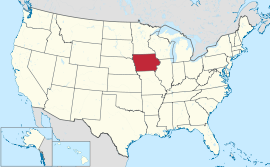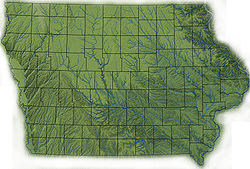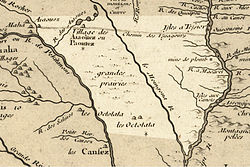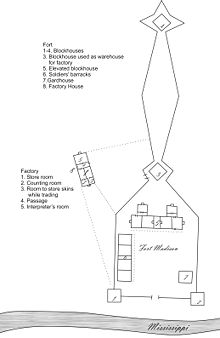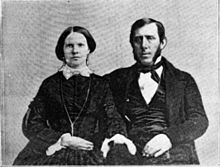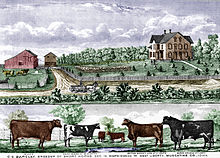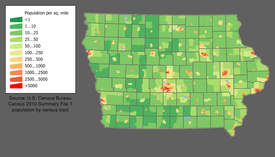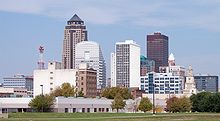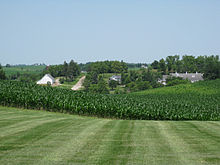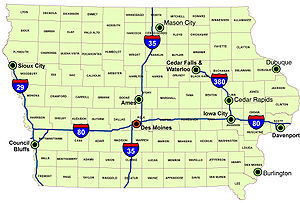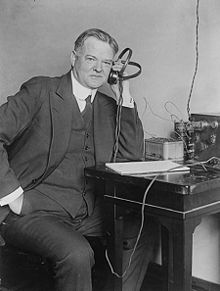- Iowa
-
This article is about the U.S. state of Iowa. For other uses, see Iowa (disambiguation).
State of Iowa 

Flag Seal Nickname(s): The Hawkeye State[1] Motto(s): Our liberties we prize and our rights we will maintain. Official language(s) English Demonym Iowan Capital
(and largest city)Des Moines Largest metro area Des Moines metropolitan area Area Ranked 26th in the U.S. - Total 56,272 sq mi
(145,743 km2)- Width 310 miles (500 km) - Length 199 miles (320 km) - % water 0.71 - Latitude 40° 23′ N to 43° 30′ N - Longitude 90° 8′ W to 96° 38′ W Population Ranked 30th in the U.S. - Total 3,046,355 (2010)[2] - Density 53.5/sq mi (20.7/km2)
Ranked 35th in the U.S.- Median income $48,075 (24th) Elevation - Highest point Hawkeye Point[3][4]
1,671 ft (509 m)- Mean 1,100 ft (340 m) - Lowest point Confluence of Mississippi River and Des Moines River[3][4]
480 ft (146 m)Before statehood Iowa Territory Admission to Union December 28, 1846 (29th) Governor Terry E. Branstad (R) Lieutenant Governor Kim Reynolds (R) Legislature General Assembly - Upper house Senate - Lower house House of Representatives U.S. Senators Chuck Grassley (R)
Tom Harkin (D)U.S. House delegation 3 Democrats, 2 Republicans (list) Time zone Central: UTC-6/-5 Abbreviations IA US-IA Website iowa.gov Iowa
 i/ˈaɪ.əwə/ is a state located in the Midwestern United States, an area often referred to as the "American Heartland". It derives its name from the Ioway people, one of the many American Indian tribes that occupied the state at the time of European exploration.[5] Iowa was a part of the French colony of New France. After the Louisiana Purchase, settlers laid the foundation for an agriculture-based economy in the heart of the Corn Belt.[6] Iowa is often known as the "Food Capital of the World".[7] However, Iowa's economy, culture, and landscape are diverse.
i/ˈaɪ.əwə/ is a state located in the Midwestern United States, an area often referred to as the "American Heartland". It derives its name from the Ioway people, one of the many American Indian tribes that occupied the state at the time of European exploration.[5] Iowa was a part of the French colony of New France. After the Louisiana Purchase, settlers laid the foundation for an agriculture-based economy in the heart of the Corn Belt.[6] Iowa is often known as the "Food Capital of the World".[7] However, Iowa's economy, culture, and landscape are diverse.In the latter half of the 20th century, Iowa's agricultural economy transitioned to a diversified economy of advanced manufacturing, processing, financial services, biotechnology, and green energy production.[7][8] The state has a population of just over 3 million (2010) and its capital and largest city is Des Moines. Iowa has been listed as one of the safest states in which to live.[9]
Geography
Boundaries
See also: List of counties in IowaIowa is bordered by the Mississippi River on the east; the Missouri River and the Big Sioux River on the west; the northern boundary is a line along 43 degrees, 30 minutes north latitude.[10][note 1] The southern border is the Des Moines River and a line along approximately 40 degrees 35 minutes north, as decided by the U.S. Supreme Court in Missouri v. Iowa[11] after a standoff between Missouri and Iowa known as the Honey War.[12]
Iowa has 99 counties, but 100 county seats because Lee County has two. The state capital, Des Moines, is located in Polk County.[13]
Geology and terrain
Main article: Geology of IowaIowa's bedrock geology generally increases in age from west to east. In northwest Iowa Cretaceous bedrock can be 74 million years old, in eastern Iowa Cambrian bedrock dates to ca. 500 million years ago.[14]
Iowa is generally not flat; most of the state consists of rolling hills. Prior[15] divides Iowa into eight landforms based on glaciation, soils, topography, and river drainage. Loess hills lie along the western border of the state, some of which are several hundred feet thick.[16] In the northeast, along the Mississippi River, is a section of the Driftless Zone, which in Iowa consists of steep hills and valleys which appear almost mountainous.
There are several natural lakes in the state, most notably Spirit Lake, West Okoboji Lake, and East Okoboji Lake in northwest Iowa (see Iowa Great Lakes). To the east lies Clear Lake. Man-made lakes include Lake Odessa,[17] Saylorville Lake, Lake Red Rock, Coralville Lake, Lake MacBride, and Rathbun Lake. The northwest part of the state also contains a considerable number of remnants of the once common wetland areas such as Barringer Slough.
Ecology and environment
Main article: Environment of IowaIowa's natural vegetation is tallgrass prairie and savanna in upland areas, with dense forest and wetlands in floodplains and protected river valleys, and pothole wetlands in northern prairie areas.[18] Most of Iowa is used for agriculture, crops cover 60% of the state, grasslands (mostly pasture and hay with some prairie and wetland) cover 30%, and forests cover 7%; urban areas and water cover another 1% each.[19] The explosion in the number of high-density livestock facilities in Iowa has led to increased risk of rural water contamination and a perceived decline in air quality.[20] Other factors negatively affecting Iowa's environment include the extensive use of older coal-fired power plants,[21] fertilizer and pesticide runoff from crop production,[22] and diminishment of the Jordan Aquifer.[23]
There is a dearth of natural areas in Iowa; less than 1% of the tallgrass prairie that once covered most of Iowa remain intact, only about 5% of the state's prairie pothole wetlands remain, and most of the original forest has been lost.[24] Iowa ranks 49th of U.S. states in public land holdings.[25] Threatened or endangered animals in Iowa include the Bald Eagle, Interior Least Tern, Piping Plover, Indiana Bat, Pallid Sturgeon, the Iowa Pleistocene Land Snail, Higgins' Eye Pearly Mussel, and the Topeka Shiner.[26] Endangered or threatened plants include Western Prairie Fringed Orchid, Eastern Prairie Fringed Orchid, Mead's Milkweed, Prairie Bush Clover, and Northern Wild Monkshood.[27]
Climate
Iowa, like most of the Midwest, has a humid continental climate throughout the state (Koppen climate classification Dfa) with extremes of both heat and cold. The average annual temperature at Des Moines is 50 °F (10 °C); for some locations in the north the figure is under 45 °F (7 °C), while Keokuk, on the Mississippi River, averages 52 °F (11 °C). Winters are often harsh and snowfall is common.
Spring ushers in the beginning of the severe weather season. Iowa averages about 50 days of thunderstorm activity per year.[28] Tornadoes are common during the spring and summer months, with an average of 37 tornadoes in a single year.[29] In 2008, twelve people were killed by tornadoes in Iowa, making it the deadliest year since 1968 and also the second most tornadoes in a year with 105, matching the total from 2001.[30]
Iowa summers are known for heat and humidity, with daytime temperatures often near 90 °F (32 °C) and sometimes exceeding 100 °F (38 °C). Average winters in the state have been known to drop well below freezing, even dropping below −18 °C (−0 °F). Iowa's all time hottest temperature of 118 °F (48 °C) was recorded at Keokuk on July 20, 1934; the all time lowest temperature of −47 °F (−44 °C) was recorded at Elkader on February 3, 1996.
Monthly Normal High and Low Temperatures For Various Iowa Cities (°F) City Jan Feb Mar Apr May Jun Jul Aug Sep Oct Nov Dec Davenport[31] 30/13 36/19 48/29 61/41 72/52 81/63 85/68 83/66 76/57 65/45 48/32 35/20 Des Moines[32] 31/14 36/19 49/30 62/41 72/52 82/62 86/67 84/65 76/55 63/43 48/31 34/18 Keokuk[33] 34/17 39/21 50/30 63/42 73/52 83/62 87/67 85/65 78/56 66/44 51/33 33/21 Mason City[34] 24/6 29/12 41/23 57/35 69/46 79/57 82/61 80/58 73/49 60/37 43/25 28/11 Sioux City[35] 31/10 35/15 47/26 62/37 73/49 82/59 86/63 83/63 76/51 63/38 46/25 32/13 [1] Iowa has a relatively smooth gradient of varying precipitation across the state, with areas in the southeast of the state receiving an average of over 38 inches of rain annually, and the northwest of the state receiving less than 28 inches.[36] The pattern of precipitation across Iowa is seasonal, with more rain falling in the summer months. In Des Moines, roughly in the center of the state, over two-thirds of the 34.72 inches of rain fall from April through September, and about half of the average annual precipitation falls from May through August.[37]
Prehistory

Excavation of the 3,800 year old
Edgewater Park Site.Main article: Iowa archaeologyMain article: Indians of IowaWhen American Indians first arrived in what is now Iowa more than 13,000 years ago, they were hunters and gatherers living in a Pleistocene glacial landscape. By the time European explorers visited Iowa, American Indians were largely settled farmers with complex economic, social, and political systems. This transformation happened gradually. During the Archaic period (10,500–2,800 years ago), American Indians adapted to local environments and ecosystems, slowly becoming more sedentary as populations increased.
More than 3,000 years ago, during the Late Archaic period, American Indians in Iowa began utilizing domesticated plants. The subsequent Woodland period saw an increased reliance on agriculture and social complexity, with increased use of mounds, ceramics, and specialized subsistence. During the Late Prehistoric period (beginning about AD 900) increased use of maize and social changes led to social flourishing and nucleated settlements.
The arrival of European trade goods and diseases in the Protohistoric period led to dramatic population shifts and economic and social upheaval, with the arrival of new tribes and early European explorers and traders. There were numerous Indian tribes living in Iowa at the time of early European exploration. Tribes which were probably descendants of the prehistoric Oneota include the Dakota, Ho-Chunk, Ioway, and Otoe. Tribes which arrived in Iowa in the late prehistoric or protohistoric periods include the Illiniwek, Meskwaki, Omaha, and Sauk.[38]
History
Main article: History of IowaEarly exploration and trade, 1673–1808
The first known European explorers to document Iowa were Jacques Marquette and Louis Jolliet who traveled the Mississippi River in 1673 documenting several Indian villages on the Iowa side.[39][40] The area of Iowa was claimed for France and remained a French territory until 1763. The French, prior to their impending defeat in the French and Indian War, transferred ownership to their ally, Spain.[41] Spain practiced very loose control over the Iowa region, granting trading licenses to French and British traders, who established trading posts along the Mississippi and Des Moines Rivers.[39]
Iowa was part of a territory known as La Louisiane or Louisiana, and European traders were interested in lead and furs obtained by Indians. The Sauk and Meskwaki effectively controlled trade on the Mississippi in the late 18th century and early 19th century. Among the early traders on the Mississippi were Julien Dubuque, Robert La Salle, and Paul Marin.[39] Along the Missouri River at least five French and English trading houses were built prior to 1808.[42] In 1800, Napoleon Bonaparte took control of Louisiana from Spain in a treaty.
After the 1803 Louisiana Purchase, Iowa was placed under United States control. Much of Iowa was mapped by Zebulon Pike in 1805,[43] but it was not until the construction of Fort Madison in 1808 that the U.S. established tenuous military control over the region.[44]
War of 1812 and unstable U.S. control
Fort Madison was built to control trade and establish U.S. dominance over the Upper Mississippi, but it was poorly designed and disliked by the Sauk and Ho-Chunk, many of whom allied with the British, who had not abandoned claims to the territory.[44][45] Fort Madison was defeated by British-supported Indians in 1813 during the War of 1812, and Fort Shelby in Prairie du Chien, Wisconsin, also fell to the British. Black Hawk took part in the siege of Fort Madison.[46][47]
After the war, the U.S. reestablished control of the region through the construction of Fort Armstrong, Fort Snelling in Minnesota, and Fort Atkinson in Nebraska.[48]
Trade and Indian removal, 1814–1832
The U.S. encouraged settlement of the east side of the Mississippi and removal of Indians to the west. Trade continued in furs and lead, but disease and forced population movement decimated Indian cultures and economies. A disputed 1804 treaty between Quashquame and William Henry Harrison that surrendered much of Illinois to the U.S. enraged many Sauk and led to the 1832 Black Hawk War. As punishment for the uprising, and as part of a larger settlement strategy, treaties were subsequently designed to remove all Indians from Iowa.
The Sauk and Meskwaki were pushed out of the Mississippi valley in 1832, out of the Iowa River valley in 1843, and out of Iowa altogether in 1846. Many Meskwaki later returned to Iowa and settled near Tama, Iowa; the Meskwaki Settlement remains to this day. In 1856 the Iowa Legislature passed an unprecedented act allowing the Meskawki to purchase the land; Indians were not usually permitted to do so. The Ho-Chunk were removed from Iowa in 1850, and the Dakota were removed by the late 1850s. Western Iowa around modern Council Bluffs was used as a way station for other tribes being moved west, including the Potawatomi.
U.S. settlement and statehood, 1832–1860


Iowa Territorial Seal. The first American settlers officially moved to Iowa in June 1833.[49] Primarily, they were families from Ohio, Pennsylvania, New York, Indiana, Kentucky, and Virginia.[49] On July 4, 1838, the U.S. Congress established the Territory of Iowa. President Martin Van Buren appointed Robert Lucas governor of the territory, which at the time had 22 counties and a population of 23,242.[50]
Almost immediately after achieving territorial status, a clamor arose for statehood. On December 28, 1846, Iowa became the 29th state in the Union when President James K. Polk signed Iowa's admission bill into law. Once admitted to the Union, the state's boundary issues resolved, and most of its land purchased from the Indians, Iowa set its direction to development and organized campaigns for settlers and investors, boasting the young frontier state's rich farmlands, fine citizens, free and open society, and good government.[51]
Iowa has a long tradition of state and county fairs. The first and second Iowa State Fairs were held in the more developed eastern part of the state at Fairfield. The first fair was held October 25–27, 1854, at a cost of around $323. Thereafter, the fair moved to locations closer to the center of the state and in 1886 found a permanent home in Des Moines. The State Fair has been held every year since except for the year 1898 due to the Spanish-American War and the World's Fair being held in nearby Omaha, Nebraska. The fair was also a World War II wartime casualty from 1942–1945.[52]
Civil War, 1861–1865
Iowa supported the Union during the Civil War, voting heavily for Abraham Lincoln, though there was a strong antiwar "Copperhead" movement among settlers of southern origins and among Catholics.[citation needed] There were no battles in the state, but Iowa sent large supplies of food to the armies and the eastern cities. Much of Iowa's support for the Union can be attributed to Samuel J. Kirkwood, its wartime governor. Of a total population of 675,000, about 116,000 men were subjected to military duty. Iowa contributed proportionately more men to Civil War military service than did any other state, north or south, sending more than 75,000 volunteers to the armed forces, over one-sixth of whom were in their graves before Appomattox.[53]
Most fought in the great campaigns in the Mississippi Valley and in the South.[54] Iowa troops fought at Wilson's Creek in Missouri, Pea Ridge in Arkansas, Forts Henry and Donelson, Shiloh, Chattanooga, Chickamauga, Missionary Ridge, and Rossville Gap as well as Vicksburg, Iuka, and Corinth. They served with the Army of the Potomoc in Virginia and fought under Union General Philip Sheridan in the Shenandoah Valley. Many died and were buried at Andersonville. They marched on General Nathaniel Banks' ill-starred expedition to the Red River. Twenty-seven Iowans have been awarded the Medal of Honor, the highest military decoration awarded by the United States government, which was first awarded in the Civil War.[55]
Iowa had several brigadier generals and four major generals—Grenville Mellen Dodge, Samuel R. Curtis, Francis J. Herron, and Frederick Steele—and saw many of its generals go on to state and national prominence following the war.[53]
Agricultural expansion, 1865–1930
Following the Civil War, Iowa's population continued to grow dramatically, from 674,913 people in 1860 to 1,194,020 in 1870. The introduction of railroads in the 1850s and 1860s transformed Iowa into a major agricultural producer.
In 1917, the United States entered World War I and farmers as well as all Iowans experienced a wartime economy. For farmers, the change was significant. Since the beginning of the war in 1914, Iowa farmers had experienced economic prosperity. In the economic sector, Iowa also has undergone considerable change. Beginning with the first farm-related industries developed in the 1870s, Iowa has experienced a gradual increase in the number of business and manufacturing operations.
Depression, World War II, and the rise of manufacturing, 1930–1985
The transition from an agricultural economy to a mixed economy happened slowly. The Great Depression and World War II accelerated the shift away from smallholder farming to larger farms, and began a trend of urbanization that continues. The period since World War II has witnessed a particular increase in manufacturing operations. While agriculture continued to be the state's dominant industry, Iowans also produce a wide variety of products including refrigerators, washing machines, fountain pens, farm implements, and food products.
The Farm Crisis of the 1980s caused a major recession in Iowa, causing poverty not seen since the Depression.[56] The crisis spurred a major population decline in Iowa that lasted a decade.[57]
Reemergence as a mixed economy, 1985–present
After bottoming out in the 1980s, Iowa's economy began to become increasingly less dependent on agriculture, and now has a mix of manufacturing, biotechnology, finance and insurance services, and government services.[58] The population of Iowa has increased at a faster rate than the U.S. as a whole,[57] and Iowa now has a predominantly urban population.[59]
Demographics
Major Cities
See also: List of cities in IowaIowa's largest cities and their surrounding areas. Recorded by the United States Census Bureau City
RankCity 2000 City
Population
[60]2010 City
Population
[61]Metropolitan Statistical Area 2010 Metro
Population
[62]1 Des Moines 198,682 203,433 Des Moines-West Des Moines MSA 569,633 2 Cedar Rapids 120,758 126,326 Cedar Rapids MSA 257,940 3 Davenport 98,359 99,685 Davenport-Moline-Rock Island MSA 379,690 4 Sioux City 85,013 82,684 Sioux City MSA 143,577 5 Waterloo 68,747 68,406 Waterloo-Cedar Falls MSA 167,819 6 Iowa City 62,220 67,862 Iowa City MSA 152,586 7 Council Bluffs 58,268 62,230 Omaha-Council Bluffs MSA 865,350 8 Ames 50,731 58,965 Ames MSA 89,542 9 Dubuque 57,686 57,637 Dubuque MSA 93,653 10 West Des Moines 46,403 56,609 Des Moines-West Des Moines MSA 569,633 11 Ankeny 27,117 45,582 Des Moines-West Des Moines MSA 569,633 12 Urbandale 29,072 39,463 Des Moines – West Des Moines MSA 569,633 13 Cedar Falls 36,145 39,260 Waterloo-Cedar Falls MSA 167,819 14 Marion 26,294 34,768 Cedar Rapids MSA 257,940 15 Bettendorf 31,275 33,217 Davenport-Moline-Rock Island MSA 379,690 Population
Historical populations Census Pop. %± 1840 43,112 — 1850 192,214 345.8% 1860 674,913 251.1% 1870 1,194,020 76.9% 1880 1,624,615 36.1% 1890 1,912,297 17.7% 1900 2,231,853 16.7% 1910 2,224,771 −0.3% 1920 2,404,021 8.1% 1930 2,470,939 2.8% 1940 2,538,268 2.7% 1950 2,621,073 3.3% 1960 2,757,537 5.2% 1970 2,824,376 2.4% 1980 2,913,808 3.2% 1990 2,776,755 −4.7% 2000 2,926,324 5.4% 2010 3,046,355 4.1% Source: 1910–2010[2] As of 2008, Iowa has an estimated population of 3,002,555, which is an increase of about 19,000 people or 0.6%, from the prior year and an increase of 76,000 or 2.6%, since the year 2000. This is the first time the state has topped the three million mark in population. Iowa is the 30th most populated state in the country.[63] In 2007, the latest demographic information available shows that the state had a natural increase of 53,706 people in population from the last census (that is 197,163 births minus 143,457 deaths) and a decrease of 11,754 due to net migration of people out of the state.
Immigration from outside the United States resulted in a net increase of 29,386 people, while migration within the country produced a net loss of 41,140 people. 6.1% of Iowa's population were reported as under the age of five, 22.6% under 18, and 14.7% were 65 or older. Males made up approximately 49.2% of the population.[64] The population density of the state is 52.7 people per square mile.[65] The center of population of Iowa is located in Marshall County, in the city of Marshalltown.[66]
Race and ancestry
Demographics of Iowa (csv) By race White Black AIAN* Asian NHPI* 2000 (total population) 96.14% 2.51% 0.63% 1.48% 0.08% 2000 (Hispanic only) 2.68% 0.08% 0.08% 0.03% 0.01% 2005 (total population) 95.79% 2.79% 0.61% 1.67% 0.08% 2005 (Hispanic only) 3.48% 0.13% 0.09% 0.03% 0.01% Growth 2000–05 (total population) 1.01% 12.55% -2.70% 14.41% 1.01% Growth 2000–05 (non-Hispanic only) 0.12% 11.13% -5.68% 14.14% 0.05% Growth 2000–05 (Hispanic only) 31.91% 53.85% 19.33% 29.51% 7.14% * AIAN is American Indian or Alaskan Native; NHPI is Native Hawaiian or Pacific Islander Iowa's population included about 97,000 foreign-born (3.3%).[64] Iowans are mostly of Western European descent. The five largest ancestry groups in Iowa are: German (35.7%), Irish (13.5%), English (9.5%), American (6.6%), and Norwegian (5.7%).
The racial make up of the state is 91.0% White (non-Hispanic), 3.8% Hispanic, 2.5% Black or African American, 1.6% Asian, and 0.4% American Indian. One percent of respondents report two or more races.[64]
Rural to urban population shift
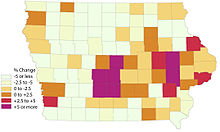

Percent population changes by counties in Iowa, 2000–2008. Purple counties have gains of more than 5%.[67] 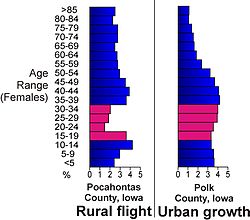

Population age comparison between rural Pocahontas County and urban Polk County, illustrating the flight of young adults (red) to urban centers in Iowa.[68] Iowa's population is more urban than rural, with 61 percent living in urban areas in 2000, a trend that began in the early 20th century.[59] Urban counties in Iowa grew 8.5% from 2000 to 2008, while rural counties declined by 4.2%.[69] The shift from rural to urban has caused population increases in more urbanized counties such as Dallas, Johnson, Linn, and Polk, at the expense of more rural counties.[70]
Iowa, in common with other Midwestern states (especially Kansas, Nebraska, North Dakota, and South Dakota), is feeling the brunt of rural flight, although Iowa has been gaining population since approximately 1990. Some smaller communities, such as Denison and Storm Lake, have mitigated this population loss through gains in immigrant laborers.[71]
Another demographic problem for Iowa is the brain drain, in which educated young adults leave the state in search of better prospects in higher education or employment. During the 1990s, Iowa had the second highest exodus rate for single, educated young adults, second only to North Dakota.[72] Significant loss of educated young people contributes to economic stagnation and the loss of services for remaining citizens.
Religion

Amana Colonies were founded by German Pietists. A 2001 survey from the City University of New York found that 52% of Iowans are Protestant, while 23% are Roman Catholic, and other religions made up 6%. 13% responded with non-religious, and 5% did not answer.[73] The largest Protestant denominations by number of adherents are the Evangelical Lutheran Church in America with 268,543; and the United Methodist Church with 248,211.[74]
The study Religious Congregations & Membership: 2000[75] found that in the southernmost two tiers of Iowa counties and in other counties in the center of the state, the largest religious group was the United Methodist Church; in the northeast part of the state, including Dubuque and Linn counties (where Cedar Rapids is located), the Roman Catholic Church was the largest; and in ten counties, including three in the northern tier, the Evangelical Lutheran Church in America was the largest. The study also found rapid growth in Evangelical Christian denominations. Dubuque is home to a Roman Catholic archdiocese, which spans the northeastern section of Iowa.
Historically, religious sects and orders who desired to live apart from the rest of society established themselves in Iowa, such as the Amish and Mennonite near Kalona and in other parts of eastern Iowa such as Davis County and Buchanan County.[76] Other religious sects and orders living apart include Quakers around West Branch and Le Grand, German Pietists who founded the Amana Colonies, followers of Transcendental Meditation who founded Maharishi Vedic City, and Cistercian monks and nuns at the New Melleray and Our Lady of the Mississippi Abbies near Dubuque.
Language
English is the most common language used in Iowa, used by 94% of the population.[77] William Labov and colleagues, in the monumental Atlas of North American English[78] found that the English spoken in Iowa divides into two large linguistic regions. Natives of northern Iowa – including Sioux City, Fort Dodge, and the Waterloo region – tend to speak the dialect that linguists call North Central American English, which is also found in North and South Dakota, Minnesota, Wisconsin, and Michigan. Natives of central and southern Iowa – including such cities as Council Bluffs, Des Moines, and Iowa City – tend to speak the North Midland dialect also found in Nebraska, central Illinois, and central Indiana.[79]
After English, Spanish is the second-most-common language spoken in Iowa, with 120,000 people in Iowa of Hispanic or Latino origin[80] and 47,000 people born in Latin America.[81] The third-most-common language is German, spoken by 17,000 people in Iowa;[77] two notable German dialects used in Iowa include Amana German spoken around the Amana Colonies, and Pennsylvania German, spoken among the Amish in Iowa. No other language is spoken by more than 0.5 percent of the Iowa population.[77] The only indigenous language used regularly in Iowa is Meskwaki, used around the Meskwaki Settlement.[82]
Attractions
Central Iowa
Des Moines is the largest city in Iowa and the state's political and economic center. It is home to the Iowa State Capitol, the State Historical Society of Iowa Museum, Drake University, Des Moines Art Center, Des Moines Botanical Center, Principal Riverwalk, the Iowa State Fair, Terrace Hill, and the World Food Prize. Nearby attractions include Adventureland in Altoona, Living History Farms in Urbandale, and the Iowa Speedway in Newton.
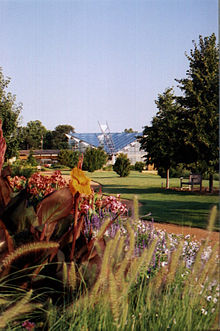

The Christina Reiman Butterfly Wing at Iowa State University, Ames. Ames is the home of Iowa State University, the Iowa State Center, and Reiman Gardens.
Boone hosts the biennial Farm Progress Show and is home to the Mamie Doud Eisenhower museum, the Boone & Scenic Valley Railroad, and Ledges State Park. The Meskwaki Settlement west of Tama is the only American Indian settlement in Iowa and is host to a large annual Pow-wow.
The Clint Eastwood movie The Bridges of Madison County, based on the popular novel of the same name, took place and was filmed in Madison County. Also in Madison County is the John Wayne Birthplace Museum in Winterset.
Other communities with vibrant historic downtown areas include Indianola, Pella, Knoxville, Marshalltown, Perry, and Story City.
Eastern Iowa
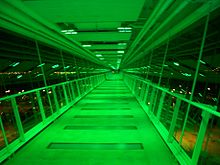

Inside the Davenport Skybridge. Iowa City is home to the University of Iowa, the Iowa Writers' Workshop, and the Old Capitol building. Iowa City is the first U.S. "City of Literature" in the UNESCO Creative Cities Network.
The Herbert Hoover National Historic Site and Herbert Hoover Presidential Library and Museum are located in West Branch.
The Amana Colonies are a group of settlements of German Pietists comprising seven villages listed as National Historic Landmarks.
The Cedar Rapids Museum of Art has collections of paintings by Grant Wood and Marvin Cone. Cedar Rapids is also home to the National Czech & Slovak Museum & Library and the Brucemore mansion.
Davenport boasts the Figge Art Museum, River Music Experience, Putnam Museum and IMAX Theater, Davenport Skybridge, Quad City Symphony Orchestra, Ballet Quad Cities, and plays host to the annual Bix Beiderbecke Memorial Jazz Festival.
Other communities with vibrant historic downtown areas include West Liberty, Fairfield, Burlington, Mount Pleasant, Fort Madison, LeClaire, Mount Vernon, Ottumwa, Washington, and Wilton.
Western Iowa
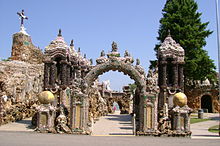

View of Grotto of the Redemption’s Lower Arcade: Small Stations of the Cross, West Bend. Some of the most dramatic scenery in Iowa is found in the unique Loess Hills. The Iowa Great Lakes include several resort areas such as Spirit Lake, Arnolds Park, and the Okoboji Lakes. The Sanford Museum and Planetarium in Cherokee, Grotto of the Redemption in West Bend, Danish Immigrant Museum in Elk Horn, and the Fort Museum and Frontier Village in Fort Dodge are regional destinations.
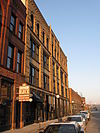

Historic Fourth Street, Sioux City. Sioux City boasts a revitalized downtown, attractions include the Sergeant Floyd Monument, Sergeant Floyd River Museum, and the Orpheum Theater.


Loess Hills east of Mondamin. Council Bluffs, the major city of southwest Iowa, sits at the base of the Loess Hills National Scenic Byway. With three casino resorts, the city also includes such cultural attractions as the Western Hills Trails Center, Union Pacific Railroad Museum, the Grenville M. Dodge House, and the Lewis and Clark Monument.
Northwest Iowa is home to some of the largest concentrations of wind turbine farms in the world. Other western communities with vibrant historic downtown areas include Storm Lake, Spencer, Le Mars, Glenwood, Carroll, Atlantic, Red Oak, Denison, Creston, Mount Ayr, Sac City, and Walnut.
Northeast and Northern Iowa
The Driftless Area of northeast Iowa has many steep hills and deep valleys, checkered with forest and terraced fields. Effigy Mounds National Monument in Allamakee and Clayton Counties has the largest assemblage of animal-shaped prehistoric mounds in the world.
Waterloo is home of the Grout Museum and is headquarters of the Silos & Smokestacks National Heritage Area. Cedar Falls is home of the University of Northern Iowa.
Dubuque is a regional tourist destination with attractions such as the National Mississippi River Museum and Aquarium and the Port of Dubuque.
Dyersville is home to the famed Field of Dreams baseball diamond. Maquoketa Caves State Park, near Maquoketa, contains more caves than any other state park.
Fort Atkinson State Preserve in Fort Atkinson has the remains of an original 1840s Dragoon fortification.
Other communities with vibrant historic downtown areas include Decorah, McGregor, Mason City, Elkader, Guttenberg, Algona, Spillville, Charles City, and Independence.
Statewide
RAGBRAI – the Register's Annual Great Bike Ride Across Iowa – attracts thousands of bicyclists and support personnel. It has crossed the state on various routes each year since 1973. Iowa is home to more than 70 wineries,[83] and hosts five regional wine tasting trails.[84] Many Iowa communities hold farmers' markets during warmer months, these are typically weekly events, but larger cities can host multiple markets.[85]
Economy
CNBC's list of "Top States for Business in 2010" has recognized Iowa as the sixth best state in the nation in the overall score. In the 10 individual categories, Iowa's best ranking was being 1st when it came to the "Cost of Doing Business", this includes all taxes, utility costs, and other costs associated with doing business. 10th in the "Economy" rankings, 12th in "Business Friendliness", 16th in "Education", 17th in both "Cost of Living" and "Quality of Life", 20th in "Workforce", 29th in "Technology and Innovation", 32nd in "Transportation" and the lowest ranking was 36th in "Access to Capital"[86]
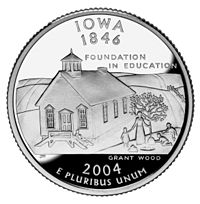

Iowa state quarter with reverse image based on a painting by American artist Grant Wood. 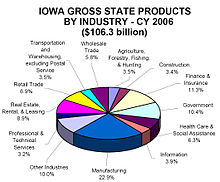

Iowa gross state products by industry, 2006.[87] While Iowa is often viewed as a farming state, in reality agriculture is a small portion of a diversified economy, with manufacturing, biotechnology, finance and insurance services, and government services contributing substantially to Iowa's economy.[58] This economic diversity has helped Iowa weather the late 2000s recession better than most states, with unemployment substantially lower than the rest of the nation.[88][89]
If the economy is measured by gross domestic product, in 2005 Iowa's GDP was about US $124 billion.[90] If measured by gross state product, for 2005 it was US $113.5 billion.[91] Its per capita income for 2006 was US $23,340.[91]
On July 2, 2009, Standard and Poor's rated the state of Iowa's credit as AAA (the highest of its credit ratings, held by only 11 U.S. state governments).[92]
As of January 2010, the states unemployment rate is 6.6%.[93]
Manufacturing
Manufacturing is the largest sector of Iowa's economy, with $20.8 billion (21%) of Iowa's 2003 gross state product. Major manufacturing sectors include food processing, heavy machinery, and agricultural chemicals. Sixteen percent of Iowa's workforce is dedicated to manufacturing.[58] Food processing is the largest component of manufacturing. Its industrial outputs include food processing, machinery, electric equipment, chemical products, publishing, and primary metals. Companies with direct or indirect processing facilities in Iowa include ConAgra Foods, Wells Blue Bunny, Barilla, Heinz, Wonder Bread/Hostess Snack Cakes, Tone's Spices, General Mills, and Quaker Oats. Major non-food advanced manufacturing firms with production facilities in Iowa include 3M, ALCOA, Amana Corporation, Dexter Apache Holdings, Inc., Electrolux/Frigidaire, Emerson Process, Fisher Controls International, HON Industries, The HON Company, IPSCO Steel, John Deere, Lennox Manufacturing, Maytag Corporation, Pella Corporation, Rockwell Collins, Vermeer Company, and Winnebago Industries.
Agriculture
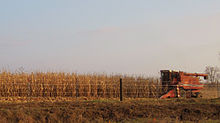

Harvesting corn in Jones County. 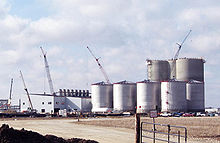

Ethanol plant under construction in Butler County. Directly and indirectly, agriculture has always been a major component of Iowa's economy. However, the direct production and sale of raw agricultural products contributes only about 3.5% of Iowa's gross state product.[94] The indirect role of agriculture in Iowa's economy can be measured in multiple ways, but its total impact, including agriculture-affiliated business, has been measured at 16.4% in terms of value added and 24.3% in terms of total output. This is lower than the economic impact in Iowa of non-farm manufacturing, which accounts for 22.4% of total value added and 26.5% of total output.[95] Iowa's main agricultural outputs are hogs, corn, soybeans, oats, cattle, eggs, and dairy products. Iowa is the nation's largest producer of ethanol and corn and some years is the largest grower of soybeans as well. In 2008, the 92,600 farms in Iowa produced 19% of the nation's corn, 17% of the soybeans, 30% of the hogs, and 14% of the eggs.[96]
Major Iowa agricultural product processors include Archer Daniels Midland, Ajinomoto, Cargill, Inc., Diamond V Mills, Garst Seed Company, Heartland Pork Enterprises, Hy-Vee, Monsanto Company, Pioneer Hi-Bred International, and Quaker Oats.[98]
Other sectors
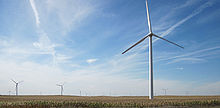

Wind turbines near Williams. Iowa also has a strong financial and insurance sector, with approximately 6,100 firms,[58] including AEGON, Nationwide Group, Aviva USA, Farm Bureau Financial Services, ING, Marsh Affinity Group, MetLife, Principal Financial Group, Principal Capital Management, Wellmark Blue Cross & Blue Shield (which, according to the American Medical Association, provided 71% of the state's health insurance in 2007),[99] Wells Fargo, and Wells Fargo Financial Services. Biotechnology has expanded dramatically in Iowa in the past decade, with firms including Bio-Research Products Inc., Boehringer Ingelheim, Vetmedica, Diosynth, Inc., Fort Dodge Animal Health, Penford Products Co., Integrated DNA Technologies., Roche Applied Science, Wacker Biochem Corp., and Wyeth.
Ethanol production consumes approximately one-third of Iowa's corn production, and renewable fuels account for 8% of the state's gross domestic product. A total of 39 ethanol plants produced 3.1 billion US gallons (12,000,000 m3) of fuel in 2009.[100] In addition to ethanol, renewable energy has become a major economic force in western Iowa, with wind turbine electrical generation increasing exponentally since 1990.[8] As of 2008, wind accounted for 15% of energy produced and 7.1% of the state's power needs; Iowa ranked second in wind generating capacity of U.S. states behind Texas.[101] Major producers of turbines and components in Iowa include Acciona Energy of West Branch, TPI Composites of Newton, and Siemens Energy of Fort Madison.
Iowa is the headquarters for five of the top 1,000 companies for revenue.[102] They include Principal Financial, Rockwell Collins, Casey's General Stores, HNI, and Terra Industries. Iowa is also headquarters to other companies including Hy-Vee, Pella Corporation, Vermeer Company, Kum & Go gas stations, Von Maur, Pioneer Hi-Bred, McLeodUSA, and Fareway grocery stores.
Taxation
Iowa imposes taxes on net state income of individuals, estates, and trusts. There are currently nine income tax brackets, ranging from 0.36% to 8.98%. The state sales tax rate is 6%, with non-prepared food having no tax.[103] Iowa has one local option sales tax that may be imposed by counties after an election.[104] Property tax is levied on the taxable value of real property. Iowa has more than 2,000 taxing authorities. Most property is taxed by more than one taxing authority. The tax rate differs in each locality and is a composite of county, city or rural township, school district and special levies. Iowa allows its residents to deduct their federal income taxes from their state income taxes.[105]
Transportation
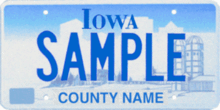

The previous state license plate design, introduced in 1996. 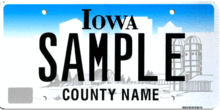

The current state license plate design, introduced in 2011. The 2011 American State Litter Scorecard ranked Iowa amongst the top four "Best" states, for overall effectiveness and quality of its statewide public space cleanliness, from state and related roadway (and adjacent property) litter/debris removal efforts—the only one in the Midwestern United States to attain that honor, that year.[106]
Interstate highways
Iowa has four primary interstate highways. Interstate 29 runs along the western edge of the state through Council Bluffs and Sioux City. Interstate 35 goes from the southern border to the northern border through the center of the state, including Des Moines. Interstate 74 begins at Interstate 80 just north and east of Davenport. Interstate 80 goes from the west end of the state to the east end through Council Bluffs, Des Moines, Iowa City, and the Quad Cities. Interstate 380 is an auxiliary Interstate Highway, which runs from Interstate 80 near Iowa City through Cedar Rapids ending in Waterloo and is part of the Avenue of the Saints highway.
Airports with scheduled flights
Iowa is served by several major airports including the Des Moines International Airport, the Eastern Iowa Airport, in Cedar Rapids, Quad City International Airport, which is located in Moline, Illinois, and Eppley Airfield, located in Omaha, Nebraska. Smaller airports in the state include the Davenport Municipal Airport (Iowa), Dubuque Regional Airport, Fort Dodge Regional Airport, Mason City Municipal Airport, Sioux Gateway Airport, Southeast Iowa Regional Airport, and Waterloo Regional Airport.
Railroads
Amtrak's California Zephyr serves the south of Iowa with stops at Burlington, Mount Pleasant, Ottumwa, Osceola, and Creston on its daily route between Chicago and Emeryville, California (across the bay from San Francisco). Fort Madison is served by Amtrak's Southwest Chief, running daily between Chicago and Los Angeles.
Law and government
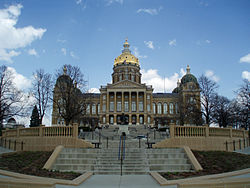

The Iowa State Capitol, completed in 1886, is the only state capitol to feature five domes, a central golden dome surrounded by four smaller domes. 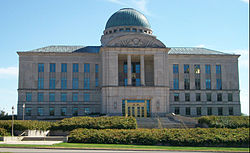

The Iowa Supreme Court, located on Court Avenue across from the state capitol in Des Moines, is the state's highest court. The current Governor is Terry E. Branstad (R)
Other statewide elected officials are:
- Kim Reynolds (R) – Lieutenant Governor
- Matt Schultz (R) – Secretary of State
- David Vaudt (R) – Auditor of State
- Michael Fitzgerald (D) – Treasurer of State
- Bill Northey (R) – Secretary of Agriculture
- Tom Miller (D) – Attorney General
The two U.S. Senators:
Further information: List of United States Senators from Iowa- Tom Harkin (D)
- Chuck Grassley (R)
The five U.S. Congressmen:
- Bruce Braley (D) – First District
- Dave Loebsack (D) – Second District
- Leonard Boswell (D) – Third District
- Tom Latham (R) – Fourth District
- Steve King (R) – Fifth District
The Code of Iowa contains the statutory laws of the state of Iowa. It is periodically updated by the Iowa Legislative Service Bureau, with a new edition published in odd-numbered years and a supplement published in even-numbered years.
Iowa is an alcohol monopoly or Alcoholic beverage control state.
Political parties
Main article: Political party strength in Iowa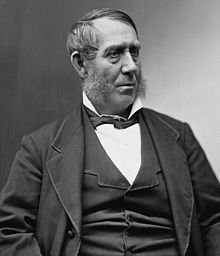

Samuel J. Kirkwood, founder of the Iowa Republican Party, abolitionist, and Iowa's Civil War governor. In Iowa, the term "political party" refers to political organizations which have received two percent or more of the votes cast for president or governor in the "last preceding general election".[107] Iowa recognizes two political parties – the Republican Party and the Democratic Party. Third parties, officially termed "nonparty political organizations" can appear on the ballot as well – five of these have had candidates on the ballot in Iowa since 2004 for various positions: the Constitution Party, the Iowa Green Party, the Libertarian Party, the United States Pirate Party, and the Socialist Workers Party.[108][109]
Voter trends
Presidential elections results Year Republican Democratic 2008 44.74% 677,508 54.04% 818,240 2004 49.92% 751,957 49.28% 741,898 2000 48.22% 634,373 48.60% 638,517 1996 39.92% 492,644 50.31% 620,258 1992 37.33% 504,890 43.35% 586,353 1988 44.8% 545,355 55.1% 670,557 1984 53.32% 703,088 45.97% 605,620 For many years, Iowa was strongly Republican. From statehood until 1969, it elected only three Democrats to the U.S. Senate. Since the 1980s, however, it has become more of a swing state in national politics. The state currently leans slightly Democratic, according to the Cook Partisan Voting Index, which by analyzing recent elections gives Iowa a score of D+1. However, the state is far from homogeneous in its political leanings. Generally, eastern Iowa is strongly Democratic while western Iowa is strongly Republican. Central Iowa is more split, though Des Moines tends Democratic. Cook finds that Iowa's five political districts range in political orientation. Iowa's 2nd congressional district, in the Eastern/Southeastern part of the state, leans distinctly Democratic, with a D+7 (strong Democratic) score; but Iowa's 5th congressional district, which covers most of Western Iowa, leans strongly Republican, scoring R+9.
From 1968 to 1984, Iowa voted for the Republican candidate in the presidential election, and from 1988 to 2000 the state voted for the Democrat; in the latter election, the Democratic candidate won by little more than 4,000 votes. In the 2004 election, Iowa went by about 10,000 votes for George W. Bush but in 2008, Barack Obama won by a much larger margin of about 150,000 votes.
In the 2006 elections, the Iowa Democrats gained two seats in the Iowa delegation to the United States House of Representatives, and Democrats won a majority in both houses of the Iowa General Assembly.
Presidential caucus
Main article: Iowa caucusThe state gets considerable attention every four years because it holds the first presidential caucuses, gatherings of voters to select delegates to the state conventions. Along with the New Hampshire primary the following week, Iowa's caucuses have become the starting points for choosing the two major-party candidates for president. The caucuses, held in January of the election year, involve people gathering in homes or public places and choosing their candidates, rather than casting secret ballots as is done in a primary election. The national and international media give Iowa (and New Hampshire) much of the attention accorded the national candidate selection process, which gives Iowa voters enormous leverage. Those who enter the caucus race often expend enormous effort to reach voters in each of Iowa's 99 counties.
Civil rights
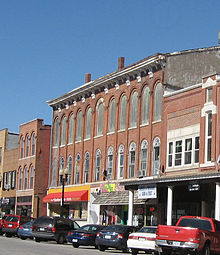

The Union Block building, Mount Pleasant, scene of early civil rights and women's rights activities. Listed as one of the most endangered historic sites in Iowa, it is to be rehabilitated. [110] In the 19th century Iowa was among the earliest states to enact prohibitions against race discrimination, especially in education, but was slow to achieve full integration in the 20th century. In the very first decision of the Iowa Supreme Court – In Re the Matter of Ralph,[111] decided July 1839 – the Court rejected slavery in a decision that found that a slave named Ralph became free when he stepped on Iowa soil, 26 years before the end of the Civil War.[112] The state did away with racial barriers to marriage in 1851, more than 100 years before the U.S. Supreme Court would ban miscegenation statutes nationwide.[113]
The Iowa Supreme Court decided Clark v. The Board of Directors[114] in 1868, ruling that racially segregated "separate but equal" schools had no place in Iowa, 85 years before Brown v. Board of Education.[112] By 1875 a number of additional court rulings effectively ended segregation in Iowa schools.[115] Social and housing discrimination continued against Blacks at state universities until the 1950s.[116] The Court heard Coger v. The North Western Union Packet Co.[117] in 1873, ruling against racial discrimination in public accommodations 91 years before the U.S. Supreme Court reached the same decision.[112]
In 1884, the Iowa Civil Rights Act apparently outlawed discrimination by businesses, reading: "All persons within this state shall be entitled to the full and equal enjoyment of the accommodations, advantages, facilities, and privileges of inns, restaurants, chophouses, eating houses, lunch counters, and all other places where refreshments are served, public conveyances, barber shops, bathhouses, theaters, and all other places of amusement." However, the courts chose to narrowly apply this act, allowing de-facto discrimination to continue.[118] Racial discrimination at public businesses was not deemed illegal until 1949, when the court ruled in State of Iowa v. Katz that businesses had to serve customers regardless of race; the case began when Edna Griffin was denied service at a Des Moines drugstore.[119] Full racial civil rights were codified under the Iowa Civil Rights Act of 1965.[120]
As with racial equality, Iowa was a vanguard in women's rights in the mid-19th century, but was slow to give women the right to vote. In 1847, the University of Iowa became the first public university in the U.S. to admit men and women on an equal basis.[121] In 1869, Iowa became the first state in the union to admit women to the practice of law, with the Court ruling that women may not be denied the right to practice law in Iowa and admitting Arabella A. Mansfield to the practice of law.[112] Several attempts to grant full voting rights to Iowa women were defeated between 1870 and 1919. In 1894 women were given "partial suffrage", which allowed them to vote on issues, but not for candidates. It was not until the Nineteenth Amendment to the United States Constitution was ratified in 1920 that women had full suffrage in Iowa.[122] Although Iowa supported the Federal Equal Rights Amendment, in 1980 and 1992 Iowa voters rejected an Equal Rights Amendment to the state constitution.[123]
Post-Civil Rights era court decisions in Iowa clarified and expanded citizens' rights. The landmark U.S. Supreme Court case Tinker v. Des Moines (1969) confirmed the right of students to express political views. On April 3, 2009, the Iowa Supreme Court decided Varnum v. Brien,[124] holding in a unanimous decision,[125] that the state's law forbidding same-sex marriage was unconstitutional. This makes Iowa the third state in the U.S. and first in the Midwest to permit same-sex marriage.[126] [127]
Sister states
Iowa has eight official partner states:[128]
- Hebei Province, People's Republic of China (1983)
- Stavropol Krai, Russia (1989)
- Taiwan, Republic of China (1989)
- Terengganu, Malaysia (1987)
- Veneto Region, Italy (1997)
- Yamanashi Prefecture, Japan (1960)
- Yucatán, Mexico (1964)
- Cherkasy Oblast, Ukraine (1996)
Education
Primary and secondary schools
See also: List of school districts in IowaIowa is often credited with the start of the high school movement in the U.S. Around 1910, secondary schools as we know them today were established across the state, which was unprecedented at the time. As the high school movement gathered pace and went beyond Iowa, there was clear evidence of how more time spent in school lead to greater income.
The four-year graduation rate for high schoolers was 87.2 % in 2009.[129] The state has the third highest graduation rate in the nation.[130] Iowa continually ranks in the top 3 for ACT and SAT scores.[131] In 2009, Iowa ranked top in the nation for average SAT scores per student[132] and second in the nation for average ACT scores per student.[133] Iowa has 365 school districts,[131] and has the twelfth best student to teacher ratio of 13.8 students per teacher.[134] Teacher's pay, however, is ranked forty-second with the average salary being $39,284.[134]
The Iowa State Board of Education works with the Iowa Department of Education to provide oversight, supervision, and support for the state's education system that includes all public elementary and secondary schools, nonpublic schools that receive state accreditation, area education agencies, community colleges, and teacher preparation programs. The State Board consists of ten members: nine voting members who are appointed by the governor for six-year terms and subject to Senate confirmation; and one nonvoting student member who serves a one-year term, also appointed by the governor.
Colleges and universities


Fountain of Four Seasons and Campanile at Iowa State University in Ames. 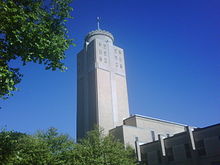

Christ the King Chapel at Saint Ambrose University in Davenport. 

Palmer Chiropractic College in Davenport is the first school of chiropractic in the world. 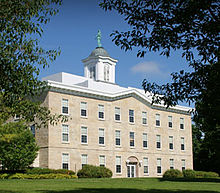

Alexander Dickman Hall, located at
Upper Iowa University in Fayette.The Iowa Board of Regents is composed of nine citizen volunteers appointed by the governor to provide policymaking, coordination, and oversight of the state's public universities, two special K-12 schools, and affiliated centers.
Iowa's three public universities include:
The special K-12 schools include the Iowa School for the Deaf in Council Bluffs and the Iowa Braille and Sight Saving School in Vinton. Both Iowa State University and the University of Iowa are major research institutions and members of the prestigious Association of American Universities. In addition to the three state universities, Iowa has multiple private colleges and universities.
Private colleges and universities include:
- Buena Vista University, Storm Lake
- Clarke University, Dubuque
- Des Moines University, Des Moines
- Divine Word College, Epworth
- Drake University, Des Moines
- Emmaus Bible College, Dubuque
- Faith Baptist Bible College and Theological Seminary, Ankeny
- Graceland University, Lamoni
- Iowa Wesleyan College, Mount Pleasant
- Kaplan University, Cedar Falls, Cedar Rapids, Council Bluffs, Davenport, Mason City, and Urbandale
- Maharishi University of Management, Fairfield
- Mount Mercy University, Cedar Rapids
- Palmer College of Chiropractic, Davenport
- Saint Ambrose University, Davenport
- University of Dubuque, Dubuque
- Upper Iowa University, Fayette
- Waldorf College, Forest City
- William Penn University, Oskaloosa
Private liberal arts colleges include:
- Ashford University, Clinton
- Briar Cliff University, Sioux City
- Central College, Pella
- Coe College, Cedar Rapids
- Cornell College, Mount Vernon
- Dordt College, Sioux Center
- Grand View University, Des Moines
- Grinnell College, Grinnell
- Loras College, Dubuque
- Luther College, Decorah
- Morningside College, Sioux City
- Northwestern College, Orange City
- Simpson College, Indianola
- Wartburg College, Waverly
Sports
See also: Sports teams from IowaIowa has professional sports teams in baseball, basketball, hockey, football and soccer. The state has four major college teams playing in Division I for all sports. In football, Iowa State University and the University of Iowa compete in the Football Bowl Subdivision (FBS), whereas the University of Northern Iowa and Drake University compete in the Football Championship Subdivision (FCS).
Baseball
Iowa has four Class A minor league teams in the Midwest League. They are the Burlington Bees, Cedar Rapids Kernels, Clinton LumberKings, and the Quad Cities River Bandits. The Sioux City Explorers are part of the American Association of Independent Professional Baseball. The Waterloo Bucks play in the Northwoods League. Des Moines is home to the Iowa Cubs, a Class AAA team in the Pacific Coast League.
Football
The Sioux City Bandits are an Indoor football team in the United Indoor Football League. The Iowa Barnstormers play in the Arena Football League. They play their home games at Wells Fargo Arena.
Hockey
The Quad City Mallards games are played in Moline, Illinois are part of the Central Hockey League.
The United States Hockey League has five teams in Iowa: the Cedar Rapids RoughRiders, Sioux City Musketeers, Waterloo Black Hawks, Des Moines Buccaneers, and the Dubuque Fighting Saints The Omaha Lancers previously played in Council Bluffs from 2002 to 2009, but have since moved back to Omaha, Nebraska. The North Iowa Outlaws play in the North American Hockey League in Mason City. The Quad City Jr Flames are a Tier III Jr. A hockey team located in Davenport, Iowa and are part of the Central States Hockey League.
Basketball
Iowa has two professional basketball teams. The Iowa Energy, an NBA Development League team that plays in Des Moines, is affiliated with the Chicago Bulls and Phoenix Suns of the NBA. The Quad Cities Riverhawks of the Premier Basketball League are based in Davenport but play at Wharton Field House in Moline, Illinois.
Soccer
The Des Moines Menace play their home games at Valley Stadium in West Des Moines.
College
The state has four NCAA Division I college teams—in NCAA FBS, the Iowa State University Cyclones of the Big 12 Conference and the University of Iowa Hawkeyes of the Big Ten Conference; in NCAA FCS, the University of Northern Iowa Panthers of the Missouri Valley Conference and Missouri Valley Football Conference (despite the similar names, the conferences are administratively separate) and the Drake University Bulldogs of the Missouri Valley Conference in most sports and Pioneer League for football.
Iowans
Main article: List of people from IowaIowa has been the birthplace of U.S. President Herbert Hoover, Vice President Henry A. Wallace, and two first ladies, Lou Henry Hoover and Mamie Eisenhower. Other national leaders who lived in Iowa include President Ronald Reagan, John L. Lewis, Harry Hopkins, Carrie Chapman Catt, Jefferson Davis, Chief Black Hawk, and John Brown.
Five Nobel Prize winners hail from Iowa: Norman Borlaug, recipient of the Nobel Peace Prize; Thomas Cech, recipient of the Nobel Prize in Chemistry; Alan J. Heeger, also a recipient of the Nobel Prize in Chemistry; John Mott, recipient of the Nobel Peace Prize; and Stanley B. Prusiner, recipient of the Nobel Prize in Physiology or Medicine. Other notable scientists who worked or were born in Iowa include astronomer and space pioneer James A. Van Allen, ecologist Aldo Leopold, computer pioneer John Vincent Atanasoff, inventor and plant scientist George Washington Carver, geochemist Clair Cameron Patterson, and Intel founder Robert Noyce.
Notable writers, artists, and news personalities from Iowa include Bill Bryson, George Gallup, Susan Glaspell, Harry Reasoner, Phil Stong, and Grant Wood.
Entertainers from Iowa include Tom Arnold, Bix Beiderbecke, Johnny Carson, Buffalo Bill Cody, Simon Estes, William Frawley, Ashton Kutcher, Cloris Leachman, Glenn Miller, Donna Reed, Brandon Routh, John Wayne, Andy Williams, Meredith Willson, and Elijah Wood.
Many athletes from Iowa have become famous enough to be noted in the List of people from Iowa. Iowan athletes winning Olympic gold medals are Dan Gable, Shawn Johnson, Edward Lindberg, Allie Morrison, George Saling, and Frank Wykoff. Iowan athletes inducted into the Baseball Hall of Fame are Cap Anson, Fred Clarke, and Bob Feller. In college football Jay Berwanger was the first winner of the Downtown Athletic Club Trophy in 1935 which was later renamed the Heisman Trophy which Nile Kinnick won in 1939. In professional football Kurt Warner was the Super Bowl XXXIV MVP winner and 2 time NFL MVP award winner. Frank Gotch was a World Heavyweight Wrestling Champion and Zach Johnson won the 2007 Masters Golf Tournament.
State symbols
- Nickname: The Hawkeye State[135][136]
- Bird: Eastern Goldfinch[137]
- Flower: Wild Rose[137]
- Grass: Bluebunch Wheatgrass[138]
- Tree: Oak[137]
- Motto: "Our liberties we prize and our rights we will maintain."[137]
- Rock: Geode[137]
See also
- Outline of Iowa
- Index of Iowa-related articles
- List of National Register of Historic Places in Iowa
- List of people from Iowa
Notes
- ^ It should be noted that the Missouri and Mississippi river boundaries are as they were mapped in the 19th century, which can vary from their modern courses.
References
- ^ "State Symbols". Iowa Department of Economic Development. http://www.traveliowa.com/statesymbols.aspx. Retrieved September 9, 2011.
- ^ a b "Resident Population Data". U.S. Census Bureau. http://2010.census.gov/2010census/data/apportionment-pop-text.php. Retrieved December 27, 2010.
- ^ a b "Elevations and Distances in the United States". United States Geological Survey. 2001. http://egsc.usgs.gov/isb/pubs/booklets/elvadist/elvadist.html. Retrieved October 21, 2011.
- ^ a b Elevation adjusted to North American Vertical Datum of 1988.
- ^ Alex, Lynn M. (2000). Iowa's Archaeological Past. University of Iowa Press, Iowa City.
- ^ Merry, Carl A. (1996). "The Historic Period". Office of the State Archeologist at the University of Iowa. http://www.uiowa.edu/~osa/learn/historic/hisper.htm. Retrieved June 29, 2009.
- ^ a b "Major Industries in Iowa" (PDF). Iowa Department of Economic Development. Archived from the original on May 20, 2005. http://www.iowalifechanging.com/downloads/iaindustries.pdf. Retrieved June 29, 2009.
- ^ a b "Wind Energy in Iowa". Iowa Energy Center. http://www.energy.iastate.edu/renewable/wind/. Retrieved August 8, 2009.
- ^ "N.H. Receives Lowest Crime Ranking; Nevada Ranks as Worst State". Insurance Journal. Wells Publishing. March 25, 2009. http://www.insurancejournal.com/news/national/2009/03/25/99012.htm?print=1. Retrieved August 8, 2009.
- ^ Preamble to the 1857 Constitution of the State of Iowa. http://www.legis.state.ia.us/Constitution.html#pre1. Retrieved August 9, 2009.
- ^ 48 U.S. (7 How.) 660 (1849).
- ^ Morrison, Jeff (January 13, 2005). "Forty-Thirty-five or fight? Sullivan's Line, the Honey War, and latitudinal estimations". http://homepage.mac.com/jeffmorrison/maps/sullivanline.html. Retrieved August 9, 2009.
- ^ "National Association of Counties". County Seats. http://www.naco.org/research/data/Pages/CountySeats.aspx. Retrieved December 24, 2010.
- ^ Prior, Jean Cutler. Geology of Iowa: Iowa's Earth History Shaped by Ice, Wind, Rivers, and Ancient Seas. Adapted from Iowa Geology 2007, Iowa Department of Natural Resources. Iowa Department of Natural Resources Geological Survey. http://www.igsb.uiowa.edu/Browse/geoiowa/GEOIOWA.HTM. Retrieved August 9, 2009.
- ^ Prior, Jean C. (1991) Landforms of Iowa. University of Iowa Press, Iowa City. Uiowa.edu
- ^ "Geology of the Loess Hills, Iowa". United States Geological Survey. July 1999. http://pubs.usgs.gov/info/loess/. Retrieved March 26, 2008.
- ^ "Odessa". Iowa Department of Natural Resources. http://www.iowadnr.com/fish/fishing/lakes/ode58.html. Retrieved June 6, 2009.
- ^ Prior, Jean C. (1991) Landforms of Iowa. University of Iowa Press, Iowa City.
- ^ Iowa DNR: Iowa's Statewide Land Cover Inventory, Uiowa.edu
- ^ "Living with Hogs in Rural Iowa". Iowa Ag Review. Iowa State University. 2003. http://www.card.iastate.edu/iowa_ag_review/summer_03/article1.aspx. Retrieved November 25, 2009.
- ^ Heldt, Diane (November 24, 2009). "Report: Many Iowa coal plants among nation's oldest". Cedar Rapids Gazette. http://gazetteonline.com/breaking-news/2009/11/24/report-many-iowa-coal-plants-among-nations-oldest. Retrieved November 25, 2009.
- ^ "Iowa Works to Reduce Run-off Polluting the Gulf of Mexico". The Iowa Journal. Iowa Public Television. September 17, 2009. http://www.iptv.org/iowajournal/story.cfm/556. Retrieved November 25, 2009.
- ^ Love, Orlan (December 6, 2009). "Heavy use draining aquifer". Cedar Rapids Gazette. http://gazetteonline.com/local-news/2009/12/06/heavy-use-draining-aquifer. Retrieved December 20, 2009.
- ^ Iowa's Threatened and Endangered Species Program, Iowadnr.gov
- ^ Iowa Must Step Up Investment in Public Lands "Des Moines Register", June 1, 2005, Nicholasjohnson.org
- ^ Federally Listed Animals in Iowa, Agriculture.state.ia.us
- ^ Federally Listed Plants in Iowa, Agriculture.state.ia.us
- ^ US Thunderstorm distribution. src.noaa.gov. Retrieved February 13, 2008.
- ^ Mean Annual Average Number of Tornadoes 1953–2004. ncdc.noaa.gov. Retrieved November 1, 2006.
- ^ "2008 Iowa tornadoes deadliest since 1968". USA Today. January 2, 2009. http://www.usatoday.com/weather/storms/tornadoes/2009-01-02-iowa-tornadoes_N.htm?csp=34. Retrieved January 2, 2009.
- ^ "Monthly Averages for Davenport, Iowa". Weather.com. http://www.weather.com/outlook/health/allergies/wxclimatology/monthly/52804. Retrieved November 1, 2008.
- ^ http://www.weather.com/outlook/health/fitness/wxclimatology/monthly/graph/USIA0231
- ^ http://www.weather.com/outlook/health/fitness/wxclimatology/daily/USIA0434
- ^ http://www.weather.com/outlook/health/fitness/wxclimatology/monthly/graph/USIA0541
- ^ http://www.weather.com/outlook/health/fitness/wxclimatology/monthly/graph/USIA0793
- ^ Average Annual Precipitation Iowa, 1961–1990 (GIF File) – Christopher Daly, Jenny Weisburg
- ^ "Average Weather for Des Moines, IA – Temperature and Precipitation, Weather.com, Retrieved Jan. 7, 2009". Weather.com. http://www.weather.com/outlook/travel/businesstraveler/wxclimatology/monthly/graph/USIA0231. Retrieved July 31, 2010.
- ^ Alex, Lynn M. (2000) Iowa's Archaeological Past. University of Iowa Press, Iowa City.
- ^ a b c Peterson, Cynthia L. (2009). "Historical Tribes and Early Forts". In William E. Whittaker. Frontier Forts of Iowa: Indians, Traders, and Soldiers, 1682–1862. Iowa City: University of Iowa Press. pp. 12–29. ISBN 978-1-58729-831-8. http://uipress.uiowa.edu/books/2009-fall/whittaker.htm.
- ^ History of Iowa, Iowa Official Register, Publications.iowa.gov
- ^ Herbermann, Charles. The Catholic Encyclopedia: An International Work of Reference on the Constitution, Doctrine, Discipline, and History of the Catholic Church. Encyclopedia Press, 1913, p. 380 (Original from Harvard University).
- ^ Carlson, Gayle F. (2009). "Fort Atkinson, Nebraska, 1820–1827, and Other Missouri River Sites". In William E. Whittaker. Frontier Forts of Iowa: Indians, Traders, and Soldiers, 1682–1862. Iowa City: University of Iowa Press. pp. 104–120. ISBN 978-1-58729-831-8. http://uipress.uiowa.edu/books/2009-fall/whittaker.htm.
- ^ Pike (1965): The expeditions of Zebulon Montgomery Pike to headwaters of the Mississippi River, through Louisiana Territory, and in New Spain, during the years June 7, 1805, Ross & Haines
- ^ a b McKusick, Marshall B. (2009). "Fort Madison, 1808–1813". In William E. Whittaker. Frontier Forts of Iowa: Indians, Traders, and Soldiers, 1682–1862. Iowa City: University of Iowa Press. pp. 55–74. ISBN 978-1-58729-831-8. http://uipress.uiowa.edu/books/2009-fall/whittaker.htm.
- ^ Prucha, Francis P. (1969) The Sword of the Republic: The United States Army on the Frontier 1783–1846. Macmillan, New York.
- ^ Jackson, Donald (1960), A Critic's View of Old Fort Madison, Iowa Journal of History and Politics 58(1) pp.31–36
- ^ Black Hawk (1882) Autobiography of Ma-Ka-Tai-Me-She-Kia-Kiak or Black Hawk. Continental Printing, St. Louis. (Originally published 1833)
- ^ Whittaker, William E. (editor) (2009). Frontier Forts of Iowa: Indians, Traders, and Soldiers, 1682–1862. Iowa City: University of Iowa Press. ISBN 978-1-58729-831-8. http://uipress.uiowa.edu/books/2009-fall/whittaker.htm.
- ^ a b Schwieder, Dorothy. "History of Iowa". Iowa State University. http://publications.iowa.gov/135/1/history/7-1.html. Retrieved June 6, 2009.
- ^ Iowa Official Register, Volume Number 60, page 314
- ^ "Official Encouragement of Immigration to Iowa", Marcus L. Hansen, IJHP", 19 (April 1921):159–95
- ^ "Iowa State Fair". Trivia. http://iowastatefair.com/about/trivia.php. Retrieved December 12, 2010.
- ^ a b Iowa Official Register, Volume No. 60, page 315
- ^ "Civil War". Iowanationalguard.com. http://www.iowanationalguard.com/Museum/IA_History/CivilWar.htm. Retrieved July 26, 2010.
- ^ Iowa Official Register, Volume No. 60, pages 315–316
- ^ The Midwest Farm Crisis of the 1980s, Tripod.com
- ^ a b Population Trends: The Changing Face of Iowa, State.ia.us
- ^ a b c d Iowa Industries, Iowa Workforce Development. Iowalifechanging.com
- ^ a b Iowa Data Center, 2000 Census: Iowadatacenter.org
- ^ "Population 2000 – Iowa Cities". United States Census Bureau American FactFinder. http://factfinder2.census.gov/faces/tableservices/jsf/pages/productview.xhtml?fpt=table. Retrieved August 4, 2011.
- ^ "Population 2010 – Iowa Cities". United States Census Bureau American FactFinder. http://factfinder2.census.gov/faces/tableservices/jsf/pages/productview.xhtml?pid=DEC_10_PL_GCTPL2.ST13&prodType=table. Retrieved August 4, 2011.
- ^ "Population 2010 – Metropolitan Statistical Area". United States Census Bureau American FactFinder. http://factfinder2.census.gov/faces/tableservices/jsf/pages/productview.xhtml?pid=DEC_10_NSRD_GCTPL2.US24PR&prodType=table. Retrieved August 6, 2010.
- ^ "DSM Register". United States Census Bureau. http://www.desmoinesregister.com/article/20081222/NEWS/81222009/1001/. Retrieved December 28, 2008.[dead link]
- ^ a b c "Iowa QuickFacts from the US Census Bureau". Quickfacts.census.gov. http://quickfacts.census.gov/qfd/states/19000.html. Retrieved July 31, 2010.
- ^ [Title=The New York Times 2008 Almanac|Author=edited by John W. Wright|Date=2007|Page=178]
- ^ "U.S. Census quickfacts". United States Census Bureau. http://quickfacts.census.gov/qfd/states/19000.html. Retrieved December 28, 2008.
- ^ Data from U.S. Census Bureau, Population Division. Modeled after Iowa Data Center Map, Iowadatacenter.org
- ^ based on 2000 U.S. Census Data
- ^ Iowans still flocking to cities, census stats show. Cedar Rapids Gazette, June 30, 2009, Gazetteonline.com
- ^ U.S. Census Bureal State and County Quick Facts, Census.gov
- ^ Grimes, William (September 14, 2005). "In This Small Town in Iowa the Future Speaks Spanish". The New York Times. http://www.nytimes.com/2005/09/14/books/14grim.html.
- ^ Iowa Brain Drain, Iowa Civic Analysis Network, University of Iowa, Uiowa.edu
- ^ "American Religious Identification Survey 2001" (PDF). The Graduate Center of the City University of New York. http://www.gc.cuny.edu/faculty/research_studies/aris.pdf. Retrieved August 16, 2007.
- ^ "The Association of Religion Data Archives | Maps & Reports". Thearda.com. http://www.thearda.com/mapsReports/reports/state/19_2000.asp. Retrieved July 26, 2010.
- ^ "Religious Congregations & Membership: 2000" (jpg). Glenmary Research Center. http://www.glenmary.org/grc/RCMS_2000/maps/Largest_Group.jpg. Retrieved April 24, 2009.
- ^ Elmer Schwieder and Dorothy Schwieder (2009) A Peculiar People: Iowa's Old Order Amish University of Iowa Press
- ^ a b c "Iowa- Languages". City Data. http://www.city-data.com/states/Iowa-Languages.html. Retrieved July 28, 2010.
- ^ Labov, W., S. Ash, and C. Boberg, Atlas of North American English. Berlin, Germany: Mouton de Gruyter, 2006. Mouton-online.com
- ^ "Atlas of North American English". The University of Pennsylvania. http://www.ling.upenn.edu/phono_atlas/maps/MapsNC/Map1NC.html. Retrieved January 5, 2008.
- ^ 2000 U.S. Census: Census.gov
- ^ 2000 U.S. Census: Census.gov
- ^ Native American Languages, Native-languages.org
- ^ ISU Extension Midwest Grape and Wine Industry Institute, Iastate.edu
- ^ Iowa Wine Growers Association, Iowawinegrowers.org
- ^ Iowa Farmers Market Association, Iafarmersmarkets.org
- ^ "America's Top States for Business in 2010". CNBC. http://www.cnbc.com/id/37516043. Retrieved May 9, 2011.
- ^ Bureau of Economic Analysis, U.S. Department of Commerce, as presented in the 2007 Iowa Factbook Des Moines:Iowa Legislative Services Agency.
- ^ Iowa's initial jobless claims grow. Des Moines Register April 2, 2009, Desmoinesregister.com
- ^ City has lowest unemployment in nation, Iowa City Press-Citizen May 5., 2009, Press-citizen.com
- ^ Iowa State University. Gross domestic product by sector and state. Regional Capacity Analysis Program. Retrieved on: April 26, 2008.
- ^ a b "Iowa Quick Facts – State Data Center". Statelibraryofiowa.org. June 28, 2010. http://www.statelibraryofiowa.org/datacenter/quickfacts. Retrieved July 31, 2010.
- ^ Iowa officials tout credit rating, argue it shows state's finances are strong, Associated Press July 3, 2009, Timesrepublican.com
- ^ Bls.gov; Local Area Unemployment Statistics
- ^ 2007 Iowa Factbook p. 59, Des Moines:Iowa Legislative Services Agency.
- ^ "Multiple Measures of the Role of Agriculture in Iowa's Economy". http://ideas.repec.org/p/isu/genres/10180.html.
- ^ State Fact Sheets: Iowa. USDA: USDA.gov
- ^ ""The Corn Parade" (1941) by Orr C. Fischer". http://historymatters.gmu.edu/d/6702. Retrieved July 3, 2010.
- ^ Ford, George (November 28, 2009). "Impact of grain-processing industry runs deep, but people don’t see it". Cedar Rapids Gazette: pp. 1A. http://gazetteonline.com/top-story/2009/11/28/impact-of-grain-processing-industry-runs-deep-but-people-don%e2%80%99t-see-it. Retrieved November 29, 2009.
- ^ Competition in Health Insurance: 2007 update, Ama-assn.org
- ^ "Ethanol mandate wouldn’t help prices". Cedar Rapids Gazette. February 26, 2010. http://gazetteonline.com/opinion/letters-to-the-editor/2010/02/26/ethanol-mandate-wouldn%e2%80%99t-help-prices. Retrieved April 4, 2010.
- ^ Report: Iowa's Wind Leadership not hurting consumers. Cedar Rapids Gazette April 14, 2009, p. 8B.
- ^ "FORTUNE 500 2009: States: Iowa Companies". CNN. http://money.cnn.com/magazines/fortune/fortune500/2009/states/IA.html.
- ^ Iowa Department of Revenue, Iowa Tax / Fee Descriptions and Rates, Iowa.gov
- ^ Iowa Department of Revenue, Iowa Local Option Tax Information, Ioawa.gov
- ^ Thomas Beaumont (May 30, 2009). "No tax increases planned for next year, Culver says". The Des Moines Register. http://www.desmoinesregister.com/apps/pbcs.dll/article?AID=2009905300328. Retrieved May 31, 2009.[dead link]
- ^ S. Spacek, 2011 American State Litter Scorecard: New Rankings for an Increasingly Environmentally Concerned Populace.
- ^ "Forming a New Political Party in Iowa" (PDF). Elections Division, Iowa Secretary of State. http://www.sos.state.ia.us/pdfs/elections/FormingPoliticalParty.pdf. Retrieved July 26, 2007.
- ^ "Official Results Report – Statewide: 2006 General Election" (PDF). Iowa Secretary of State. http://www.sos.state.ia.us/pdfs/GenOffResults.pdf. Retrieved July 26, 2007.
- ^ "Canvass Summary: 2004 General Election" (PDF). Chester J. Culver, Iowa Secretary of State. http://www.sos.state.ia.us/pdfs/elections/2004/general/CanvassSummary.pdf. Retrieved July 26, 2007.
- ^ Troute, Rex L. (August 27, 2011). "F.M., M.P. awarded Challenge Grants". Burlington Hawk Eye. http://www.thehawkeye.com/story/Challenge-grant-082811. Retrieved September 3, 2011.
- ^ 1 Morris 1 (Iowa 1839)
- ^ a b c d "Early Civil Rights Cases". Judicial.state.ia.us. http://www.judicial.state.ia.us/Public_Information/Iowa_Courts_History/Civil_Rights/. Retrieved July 26, 2010.[dead link]
- ^ Gay marriage and Iowa: Why's everyone so surprised?, Chicago Tribune, April 10, 2009
- ^ 24 Iowa 266 (1868)
- ^ Brodnax, David (2004). "The Equality of Right: Alexander Clark and the Desegregation of Iowa's Public Schools, 1834–1875". Law and Society Association. http://www.allacademic.com/meta/p_mla_apa_research_citation/1/1/7/4/2/p117420_index.html.
- ^ Breaux, Richard M. (2004) "Maintaining a Home for Girls": The Iowa Federation of Colored Women's Clubs at the University of Iowa 1919–1950, Cultural Capital and Black Education ed. V.P. Franklin and C.J. Savage. Information Age, Greenwich
- ^ 37 Iowa 145 (1873)
- ^ Iowa Civil Rights Commission, Iowa.org
- ^ African-Americans in Iowa, 1838–2005, IPTV.org
- ^ Iowa Civil Rights Commission, State.ia.us
- ^ About Iowa, Uiowa.edu
- ^ The Fight for Women's Suffrage, IPTV.org
- ^ How Did Iowa Coalitions Campaign for the Equal Rights Amendment in 1980 and 1992?, alexanderstreet.com
- ^ WL 874044 (Iowa 2009) (Publication to N.W.2d pending as of April 9, 2009.)
- ^ Martyn, Chase (August 25, 2008). "Iowa Supreme Court: Same-sex couples can marry « Iowa Independent". Iowaindependent.com. http://iowaindependent.com/13495/iowa-supreme-court-same-sex-couples-can-marry-in-iowa. Retrieved July 26, 2010.
- ^ "BREAKING: Iowa Supreme Court rules in favor of marriage equality! « Human Rights Campaign". HRC Back Story. April 3, 2009. http://hrcbackstory.org/2009/04/breaking-iowa-supreme-court-rules-in-favor-of-marriage-equality. Retrieved July 26, 2010.
- ^ "USA Today, Iowa Court Upholds Gay Marriage". USA Today. January 7, 2010. http://blogs.usatoday.com/ondeadline/2009/04/iowa-court-upholds-gay-marriage.html. Retrieved July 31, 2010.[dead link]
- ^ "Iowa Sister States". Iowa Sister States. February 23, 2010. http://www.iowasisterstates.org/. Retrieved July 31, 2010.
- ^ "Iowa Announces New NGA Graduation Rates". Iowa Department of Education. http://www.iowa.gov/educate/index.php?option=com_content&view=article&id=1979:iowa-department-of-education-announces-new-nga-graduation-rates&catid=242:news-releases. Retrieved September 13, 2010.
- ^ "High School Graduation". United Health Foundation. http://www.unitedhealthfoundation.com/shr2005/components/hsgrad.html. Retrieved January 23, 2008.[dead link]
- ^ a b "Quick Facts about Iowa Schools". Iowa Department of Education. http://www.iowa.gov/educate/content/view/281/1003/. Retrieved January 23, 2008.[dead link]
- ^ "Iowa SAT Scores Top In The Nation". Iowa Department of Education. http://www.iowa.gov/educate/index.php?option=com_content&view=article&id=1835:iowa-sat-scores-top-in-the-nation&catid=666:highlights. Retrieved September 13, 2010.
- ^ "Iowa students' ACT scores again No. 2 in nation". Des Moines Register. AUGUST 18, 2010. http://www.desmoinesregister.com/article/20100818/NEWS02/8180353/Iowa-students-ACT-scores-again-No-2-in-nation. Retrieved September 13, 2010.[dead link]
- ^ a b "Education Stats". National Education Association. http://www.nea.org/edstats/RankFull06b.htm. Retrieved January 23, 2008.[dead link]
- ^ "Iowa State Nickname – The Hawkeye State". http://www.statesymbolsusa.org/Iowa/nickname_hawkeye.html. Retrieved November 2, 2009.
- ^ "State Nicknames". http://www.50states.com/bio/nickname2.htm. Retrieved November 2, 2009.
- ^ a b c d e "Iowa General Assembly – Iowa State Symbols". legis.state.ia.us. http://www.legis.state.ia.us/Pubinfo/StateSymbols/. Retrieved November 24, 2006.
- ^ "State Facts for Students – Iowa". U.S. Census Bureau. http://www.census.gov/schools/facts/iowa.html. Retrieved November 20, 2007.
External links
- Official State of Iowa Website
- Iowa Travel and Tourism Division
- Energy Data & Statistics for Iowa- From the U.S. Department of Energy
- Iowa State Databases – Annotated list of searchable databases produced by Iowa state agencies and compiled by the Government Documents Roundtable of the American Library Association.
- U.S. Census Bureau Quick Facts
- Iowa at the Open Directory Project
 OpenStreetMap has geographic data related to Iowa
OpenStreetMap has geographic data related to Iowa

 South Dakota
South Dakota Minnesota
Minnesota Wisconsin
Wisconsin
 Nebraska
Nebraska
 Illinois
Illinois Iowa: Outline • Index
Iowa: Outline • Index 

 Kansas
Kansas Missouri
Missouri Illinois
IllinoisPolitical divisions of the United States States - Alabama
- Alaska
- Arizona
- Arkansas
- California
- Colorado
- Connecticut
- Delaware
- Florida
- Georgia
- Hawaii
- Idaho
- Illinois
- Indiana
- Iowa
- Kansas
- Kentucky
- Louisiana
- Maine
- Maryland
- Massachusetts
- Michigan
- Minnesota
- Mississippi
- Missouri
- Montana
- Nebraska
- Nevada
- New Hampshire
- New Jersey
- New Mexico
- New York
- North Carolina
- North Dakota
- Ohio
- Oklahoma
- Oregon
- Pennsylvania
- Rhode Island
- South Carolina
- South Dakota
- Tennessee
- Texas
- Utah
- Vermont
- Virginia
- Washington
- West Virginia
- Wisconsin
- Wyoming
Federal district Insular areas Outlying islands Protected Areas of Iowa Federal DeSoto • Driftless Area • Neal Smith • Northern Tallgrass Prairie • Port Louisa • Union Slough • Upper Mississippi River
State Ambrose A. Call • Backbone • Badger Creek • Banner Lakes at Summerset • Beed's Lake • Bellevue • Big Creek • Black Hawk • Brushy Creek • Cedar Rock • Clear Lake • Dolliver Memorial • Elk Rock • Elinor Bedell • Emerson Bay • Fairport • Fort Defiance • Geode • George Wyth Memorial • Green Valley • Gull Point • Honey Creek • Lacey-Keosauqua • Lake Ahquabi • Lake Anita • Lake Darling • Lake Keomah • Lake MacBride • Lake Manawa • Lake of Three Fires • Lake Wapello • Ledges • Lewis and Clark • Maquoketa Caves • Marble Beach • McIntosh Woods • Mines of Spain & E.B. Lyons • Mini-Wakan • Nine Eagles • Okamanpedan • Palisades-Kepler • Pikes Peak • Pikes Point • Pilot Knob • Pine Lake • Pleasant Creek • Prairie Rose • Preparation Canyon • Red Haw • Rice Lake • Rock Creek • Springbrook • Stone • Templar • Trapper's Bay • Twin Lakes • Union Grove • Viking Lake • Volga River • Walnut Woods • Wapsipinicon • Waubonsie • Wildcat Den • Wilson Island
Backbone • Barkley • Gifford • Holst • Loess Hills • Pilot Mound • Shimek • Stephens • White Pine Hollow • Yellow River
A.F. Miller • Ames High Prairie • Anderson Prairie • Behrens Pond and Woodlands • Berry Woods • Bird Hill • Bixby • Bluffton Fir Stand • Brush Creek Canyon • Brushy Creek • Cameron Woods • Casey's Paha • Catfish Creek • Cayler Prairie • Cedar Bluffs • Cedar Hills Sand Prairie • Cheever Lake • Clay Prairie • Claybanks Forest • Cold Water Spring • Crossman Prairie • Decorah Ice Cave • Dinesen Prairie • Doolittle Prairie • Fallen Rock • Fish Farm Mounds • Five Ridge Prairie • Fleming Woods • Fort Atkinson • Freda Haffner Kettlehole • Gitchie Manitou • Hanging Bog • Hardin City Woodland • Hartley Fort • Hayden Prairie • Hoffman Prairie • Indian Bluffs Primitive Area • Indian Fish Trap • Iowa's State Preserves System • Kalsow • Kish-Ke-Kosh Prairie • Lamson Woods • Liska-Stanek Prairie • Little Maquoketa • Malanaphy Springs • Malchow Mounds • Manikowski Prairie • Mann Wilderness Area • Marietta Sand Prairie • Mericle Woods • Merrill A. Stainbrook • Merritt Forest • Montauk • Mossy Glen • Mount Pisgah Cemetery • Mount Talbot • Nestor Stiles Prairie • Ocheyedan Mound • Old State Quarry • Palisades-Downs • Pecan Grove • Pellett Woods • Pilot Grove • Pilot Knob • Retz Woods • Roberts Creek • Rock Creek Island • Rock Island • Roggman Boreal Slopes • Rolling Thunder Prairie • Saint James Lutheran Church • Savage Woods • Searryl's Cave • Sheeder Prairie • Silver Lake Fen • Silvers-Smith Woods • Slinde Mounds • Starr's Cave • Steele Prairie • Stinson Prairie • Strasser Woods • Sylvan Runkel • Toolesboro Mounds • Turin Loess Hills • Turkey River Mounds • White Pine Hollow • Williams Prairie • Wittrock Indian Village • Woodland Mounds • Woodman Hollow • Woodthrush •
County State Parks
(Leased)Bobwhite • Cold Springs • Crystal Lake • Eagle Lake • Echo Valley • Frank A. Gotch • Heery Woods • Lake Cornelia • Lake Icaria • Kearny • Margo Frankel • Mill Creek • Oak Grove • Oakland Mills • Pammel • Sharon Bluffs • Spring Lake • Swan Lake • Three Mile Lake
Preceded by
TexasList of U.S. states by date of statehood
Admitted on December 28, 1846 (29th)Succeeded by
WisconsinCoordinates: 42°N 93°W / 42°N 93°W
United States (Outline) History Pre-Columbian era · Colonial era (Thirteen Colonies · Colonial American military history) · American Revolution (War) · Federalist Era · War of 1812 · Territorial acquisitions · Territorial evolution · Mexican–American War · Civil War · Reconstruction era · Indian Wars · Gilded Age · African-American Civil Rights Movement (1896–1954) · Spanish–American War · Imperialism · World War I · Roaring Twenties · Great Depression · World War II (Home front) · Cold War · Korean War · Space Race · African-American Civil Rights Movement (1955–1968) · Feminist Movement · Vietnam War · Post-Cold War (1991–present) · War on Terror (War in Afghanistan · Iraq War) · Timeline of modern American conservatismTopicsDemographic · Discoveries · Economic (Debt Ceiling) · Inventions (before 1890 · 1890–1945 · 1946–1991 · after 1991) · Military · Postal · Technological and industrialFederal
governmentLegislature - Congress
Senate
· Vice President
· President pro tem
House of Representatives
· Speaker
Judiciary - Supreme Court
Federal courts
Courts of appeal
District courtsExecutive - President
Executive Office
Cabinet / Executive departments
Civil service
Independent agencies
Law enforcement
Public policy
Intelligence
Central Intelligence Agency
Defense Intelligence Agency
National Security Agency
Federal Bureau of InvestigationPolitics Divisions · Elections (Electoral College) · Foreign policy · Foreign relations · Ideologies · Local governments · Parties (Democratic Party · Republican Party · Third parties) · Political status of Puerto Rico · Red states and blue states · Scandals · State governments · Uncle SamGeography Cities, towns, and villages · Counties · Extreme points · Islands · Mountains (Peaks · Appalachian · Rocky) · National Park System · Regions (Great Plains · Mid-Atlantic · Midwestern · New England · Northwestern · Southern · Southwestern · Pacific · Western) · Rivers (Colorado · Columbia · Mississippi · Missouri · Ohio · Rio Grande) · States · Territory · Water supply and sanitationEconomy Agriculture · Banking · Communications · Companies · Dollar · Energy · Federal Budget · Federal Reserve System · Financial position · Insurance · Mining · Public debt · Taxation · Tourism · Trade · Transportation · Wall StreetSociety TopicsCrime · Demographics · Education · Family structure · Health care · Health insurance · Incarceration · Languages (American English · Spanish · French) · Media · People · Public holidays · Religion · SportsArchitecture · Art · Cinema · Cuisine · Dance · Fashion · Flag · Folklore · Literature · Music · Philosophy · Radio · Television · TheaterIssuesCategories:- Iowa
- States of the United States
- Midwestern United States
- States and territories established in 1846
Wikimedia Foundation. 2010.

